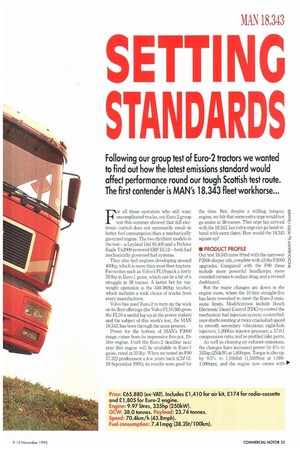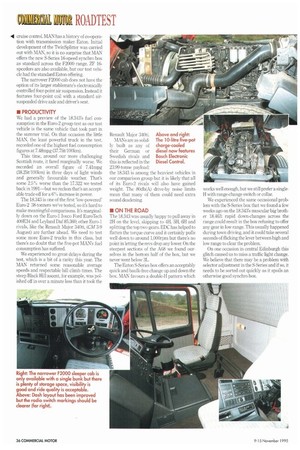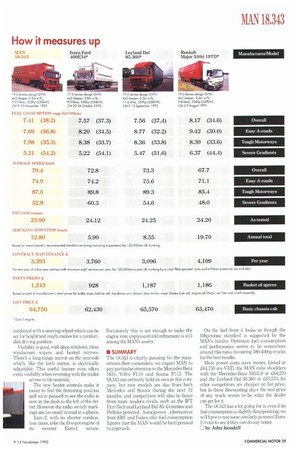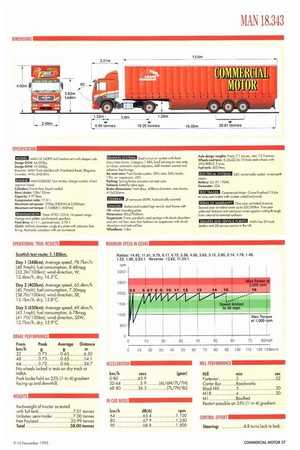SETTING STANDARDS
Page 37

Page 38

Page 40

Page 41

Page 39

If you've noticed an error in this article please click here to report it so we can fix it.
Following our group test of Euro-2 tractors we wanted to find out how the latest emissions standard would affect performance round our tough Scottish test route. The first contender is MAN's 18.343 fleet workhorse...
For all those operators who still want uncomplicated trucks, our Euro-2 group test this summer showed that full electronic control does not necessarily result in better fuel consumption than a mechanically governed engine. The two thriftiest models in the test—a Leyland Daf 85.400 and a Perkins Eagle Tx2000-powered ERF EC12—both had mechanically governed fuel systems.
They also had engines developing around 400hp, which is more than most fleet tractors. Favourites such as Volvo's FL10 pack a lowly 315hp in Euro-1 guise, which can be a bit of a struggle at 38 tonnes. A better bet for topweight operation is the 340-360hp bracket, which includes a wide choice of trucks from every manufacturer.
Volvo has used Euro-2 to turn up the wick on its fleet offerings (the Volvo FL10.360 gives the ELIO a useful leg-up in the power stakes) and the subject of this week's test, the MAN 18.343, has been through the same process.
Power for the bottom of MAN's F2000 range comes from its impressive five-pot, 10litre engine. Until the Euro-2 deadline next year this engine will be available in Euro-1 guise, rated at 315hp. When we tested its F90 17.322 predecessor a few years back (CM 1218 September 1991), its results were good for
the time. But, despite a willing, torquey engine, we felt that some extra urge would not go amiss at 38 tonnes. That urge has arrived with the 18343, but extra urge can go hand-inhand with extra thirst How would the 18.343 square up?
• PRODUCT PROFILE
Our test 18.343 Game fitted with the narrower F2000 sleeper cab, complete with all the F2000 upgrades. Compared with the F90 these include more powerful headlamps, more rounded corners to reduce drag, and a revised dashboard.
But the major changes are down in the engine room, where the 10-litre straight-five has been reworked to meet the Euro-2 emissions limits. Modifications include Bosch Electronic Diesel Control (EDC) to control the mechanical fuel injection system; counterbalance shafts rotating at twice crankshaft speed to smooth secondary vibrations; eight-hole injectors; 1,200bar injector pressure; a 17.0:1 compression ratio; and re-profiled inlet ports.
As well as cleaning up exhaust emissions, the changes have increased power by 6% to 335hp (2500) at 1,800rpm. Torque is also up, by 9.5% to 1,106lbft (1,500Ntn) at 1,0001,50Orpm, and the engine now comes with 110'
cruise control. MAN has a history of co-operation with transmission maker Eaton. Initial development of the TwinSplitter was carried out with MAN, so it is no surprise that MAN offers the new S-Series 16-speed synchro box as standard across the F2000 range. ZF 16speeders are also available, but our test vehicle had the standard Eaton offering.
The narrower F2000 cab does not have the option of its larger stablernate's electronically controlled four-point air suspension. Instead it features four-point coil with a standard airsuspended drive axle and driver's seat.
• PRODUCTIVITY We had a preview of the 18.343's fuel consumption in the Euro-2 group test as our test vehicle is the same vehicle that took part in the summer trial. On that occasion the little MAN, the least powerful truck in the test, recorded one of the highest fuel consumption figures at 7.48mpg (37.71W100km).
This time, around our more challenging Scottish route, it fared marginally worse. We recorded an overall figure of 7.41mpg (38.21it/100km) in three days of light winds and generally favourable weather. That's some 2.5% worse than the 17.322 we tested back in 1991—but we reckon that's an acceptable trade-off for a 6% increase in power.
The 18.343 is one of the first low-powered' Euro-2 38-tonners we've tested, so it's hard to make meaningful comparisons. Its marginally down on the Euro-1 Iveco Ford EuroTech 400E34 and Leyland Daf 85.360; other Euro-1 rivals, like the Renault Major 340ti, (CM 3-9 August) are further ahead. We need to test some more Euro-2 trucks in this class, but there's no doubt that the five-pot MAN'S fuel consumption has suffered.
We experienced no great delays during the test, which is a bit of a rarity this year. The MAN returned some reasonable average speeds and respectable hill climb times. The steep Black Hill ascent, for example, was polished off in over a minute less than it took the Renault Major 340ti.
MANs are as solidly built as any of their German or Swedish rivals and this is reflected in the 2399-tonne payload: the 18.343 is among the heaviest vehicles in our comparison group but it is likely that all of its Euro-2 rivals will also have gained weight. The 80db(A) drive-by noise limits mean that many of them could need extra sound deadening. Above and right: The 10-litre five-pot charge-cooled diesel now features Bosch Electronic Diesel Control.
• ON THE ROAD The 18.343 was usually happy to pull away in 2H on the level, skipping to 4H, 5H, 6H and splitting the top two gears. EDC has helped to flatten the torque curve and it certainly pulls well down to around 1,00Orpm but there's no point in letting the revs drop any lower. On the steepest sections of the A68 we found ourselves in the bottom half of the box, but we never went below 3L.
The Eaton S-Series box offers an acceptably quick and baulk-free change up and down the box. MAN favours a double-H pattern which works well enough, but we still prefer a singleH with range-change switch or collar.
We experienced the same occasional problem with the S-Series box that we found a few weeks ago on the 18.343's muscular big brother 18.463: rapid down-changes across the range could result in the box refusing to offer any gear in low range. This usually happened during town driving, and it could take several seconds of flicking the lever between high and low range to clear the problem.
On one occasion in central Edinburgh this glitch caused us to miss a traffic light change. We believe that there may be a problem with selector adjustment in the S-Series and if so, it needs to be sorted out quickly as it spoils an otherwise good synchro box. Testing the 18.343 so soon after the 18.463 underlines how big a part cab suspension plays in the handling formula. The 18.463's four-point air-suspended cab with electronic control countered roll exceptionally well. By contrast, the four-point coil springs of the 18.343 deliver comparatively alarming roll angles under similar cornering forces. Some argue that's a good way to discourage highspeed cornering, and they may be right.
In any case the 18.343 handles well, even if it lacks the poise of the more sophisticated suspension.
One thing the 18.343 shares with the 18.463 is front disc brakes. As our tests show they provide plenty of stopping power, although we did get a hint of wheel lock during our panic-stop tests.
A 10-litre engine does not provide as much potential for exhaust braking as larger engines, but with the revs in the blue sector towards the top of the rev band the exhauster can produce effective retardation on long descents.
• CAB COMFORT The upright windscreen makes maximum use of the available cab space. MAN does not pretend there is enough room for two bunks in the standard sleeper so it doesn't offer a second, even as an option. There's plenty of stowage space beneath the single bunk, which is mounted halfway up the rear wall, but anything stowed there is free to fly around under heavy braking. We would prefer to see the bunk mounted lower, but over a proper locker where gear could be securely contained.
Other storage space is found in a couple of smallish headlining lockers, a central documents bin and door pockets. Only the nearside headlining locker can be locked—OK on lefthookers, no doubt, but less useful in the UK. There are also two external lockers behind the seats, opened from inside, with barely enough room for ropes or spare suzies.
During the day the bunk hinges up and is held in place by a heavy-duty catch. Both seats or seat backs need to be moved forward to drop the bunk down at night. Generally space is a bit restricted but it's better than some rival fleet sleepers, like the Volvo FL or the Scania P-cab.
Good handling is accompanied by an acceptable if bouncy ride. The air-suspended seat adjusts in all the usual directions and, combined with a steering wheel which can be set for height and reach, makes for a comfortable driving position.
Visibility is good, with deep windows, three windscreen wipers and heated mirrors. There's a long-range mirror on the nearside which, like the kerb mirror, is electrically adjustable. This useful feature even offers extra visibility when reversing with the trailer across to the nearside.
The new heater controls make it easier to find the demisting position and we're pleased to see the radio is now in the dash to the left of the driver. However the radio switch markings are too small to read at a glance.
Euro-2, with its shorter combustion times, robs the five-pot engine of its sweeter Euro-1 nature. Fortunately this is not enough to make the engine note unpleasant and refinement is still among the IVIAN's assets.
• SUMMARY
The 18343 is clearly gunning for the mainstream fleet contenders: we expect MAN to pay particular attention to the Mercedes-Benz 1834, Volvo FL10 and Scania P113. The 18.343 can certainly hold its own in this company but new models are due from both Mercedes and Scania during the next 12 months, and competition will also be fierce from more modern rivals, such as the IFT EuroTech and Leyland Daf 85. Cummins and Perkins-powered homegrown alternatives from ERF and Foden offer fuel consumption figures that the MAN would be hard pressed to approach. On the fuel front it looks as though the 10hpitonne standard is supported by the MAN's results. Optimum fuel consumption and performance seems to lie somewhere around this ratio, favouring :380/400hp trucks for the best results.
More power costs more money. Listed at £64,750 (ex-VAT), the MAN rubs shoulders with the Mercedes-Benz 18341S at 164,270 and the Leyland Daf 85.360 at £65,570. its other competitors are cheaper on list price, but in these discounting days the real price of any truck seems to be what the dealer can get for it.
The 18.343 has a lot going for it, even if its fuel consumption is slightly disappointing: we will have to test some similarly powered Euro2 rivals to see if they can do any better.
DI by John Kendall
SPECIFICATION
MEM MAN 18 343F11 4x2 tractive unit with sleeper cab. Design GON: 441,000kg, Design GVW: 19,000k9. Importer: MAN Truck and Bus UK, Frankland Road, Blagrove, Swindon, Wits, SN5 8YU.
MESI MAN 02865LF, four-stroke, charge-cooled, direct injection diesel,
Cylinders: Five in-line, liquid cooled.
Bore/stroke: 128x155mm.
Capacity 997 litres Compression ratio: 17.0:1.
Maximum net power: 335hp 250kW1 at 2,000rpm.
Maximum net torque: 1,10616ft I1,500Nrn1
EMSEMIMI Eaton RISC 12316,16-speed rangechange and splatter synchromesh gearbox. Final drive:4.11:1; optional ratio, 3.70:1. Clutch: 430mm diameter, single dry plate with asbestos-free lining. Hydraulic actuation with air assistance, Dual-circuit air system with front 61os/rear drums. Category 1 ABS, lood sensing on rear axle, air dryer, automatic slack adjusters, ASR traction control and asbestos-free linings. Air reservoirs: Front brake system, 3014; rear, 341i1; trailer, I 514; air suspenston, 401-4.
Parking: Spring brake actuators on rear axle.
Exhaust Butterfly valve type.
Broke dimensions: Front discs, 438mm diameter; rear drums, 410x220mm.
BRAKING SYSTEMS:
MEM ZF servocom 8099, hydraulically assisted.
CHASSIS Bolted and riveted high-tensile steel frame with fifth-wheel mounting plate.
Dimensions: 80x270x8mm.
and anti-roll bar; rear, four-bellows air suspension with shock Suspension: Fronk parabolic steel springs with shock absorbers absorbers and anti-roll bar.
Wheelbase: 3_8m. Axle design weights: Front, 7.1 tonnes, rear, 13 0 tonnes. Wheels and tyres: 8.25x22.5in 10-hole steel wheels with 295/80R22 5 tyres.
Fuel tank: 400 hires.
ELECTRICAL SYSTEMS: 24V1 numerically coded, wred earth return Battery: 2x i 2V 70Ah.
Generator: 35A
MEM Commercial Motor Crane Fruehauf 13.6m ,roi i,riilnr with curtain-sided bodywork.
TERMS OF WARRANTY: Ore-year unlimited distance_ Second year driveline cover up to 200,000km. Five-year unlimited distance anti-corrosion cover against rusting through from internal Io external surfaces.
DEALERS AND SERVICE POINTS. MAN has 29 truck dealers and 28 service centres in the UK.
OPERATIONAL TRIAL RESULTS Scottish test route: 1,180km.
Day 1 (348km): Average speed, 78.7km/h (48.9mph); fuel consumption, 8.48mpg (33.314/100km); wind 'direction, W, 12.4km/h, dry, 16.5°C.
Day 21402km): Average speed, 65.4km/h (40.7mph); fuel consumption, 7.30mpg (38.7Iii/100km); wind direction, SE, 15.1km/h, dry, 13.8°C.
Day 3 (430km): Average speed, 69.4km/h 43.] mph); Fuel consumption, 6.713mpg (41.76/100km); wind direction, SSW, 12.7km/h, dry, 15.9°C.
DRIVERS' VERDICTS
Having completed our three-day test we followed our usual practice by asking some drivers to take a short drive and give their comments...
George Brinley drives a Mercedes-Benz 2534 out of Southend for Russell Davies. "My truck has only got two steps so three makes the climb seem very easy," he said as he entered the cab. "The seat is softer than in my Merc too." Out on the road he commented: "It's a bit noisier than mine on acceleration but at cruising speed it's a bit quieter." Then, as he let the engine speed fall back to little more than 500rpm on a hill and watched the revs rise again back into the green without complaint, he told us: "It hangs on a lot better; I couldn't do that in the Merc-1 would have had to drop at least one more gear. The gearbox is nice and light but the steering wheel is a bit small. The clutch is on the heavy side but all the pedals seem to be about the right height. The exhaust brake would be nice if it did anything and the foot button needs to be set a bit further forwards to make it easier to reach. I can see all the instruments. I trust it's got a night heater?" he asked. We told him it was wired in as standard. "Even with the seat locked out the ride is softer than on mine," said Brinley. "The one thing I have against this cab is that you can't stand up in it. The windows are good but the mirror on the driver's side could be longer. It could also do with a decent light over the driving seat and I'd like the roof hatch better if it worked electrically. The radio would be better in the header rail and it needs a 12-volt dropper with a 10amp fuse on the dash to power a TV and a fridge. The cab is wider than my Mem, but there is never enough room. The cab
George Brinley: "The gearbox is nice and right but the steering wheel is a bit small."
trim should only need a wipe down with a damp cloth to keep it clean but you would need a vacuum cleaner for the carpet. The outside lockers are better than
1
nothing; they'd be big enough for me to put my gloves and the odd bit of tackle."
Tony Vaughn walked over from his Daf 95.310 and with one step up he launched himself into the cab. "Visibility is good," he said as we started off. Using whole gear changes he quickly accelerated the truck up to speed. "It managed that easily enough without any help from the splitter," he said. "The engine is very torquey. It doesn't struggle so there's no need to use high revs at all. It pulls as well as our Daf 95.400," he added. "The steering is light and with the ride being so soft it feels as if it's swaying a bit at the rear end." On a downhill section he dropped down the box one slot and applied the exhaust brake. "That works well," he said, "but the foot brake is quite sensitive. Noise inside the cab is about the same as in the 95 but this is well laid out and more spacious. The overhead lockers are quite deep and the hanging wardrobe is a good idea. I prefer the radio down here on the dash where I can see to adjust it. The trim should be easy to keep clean," he concluded.
Tony Vaughn: "The engine is very torquey...it doesn t struggle so there's no need to use high revs at all."




















































































































